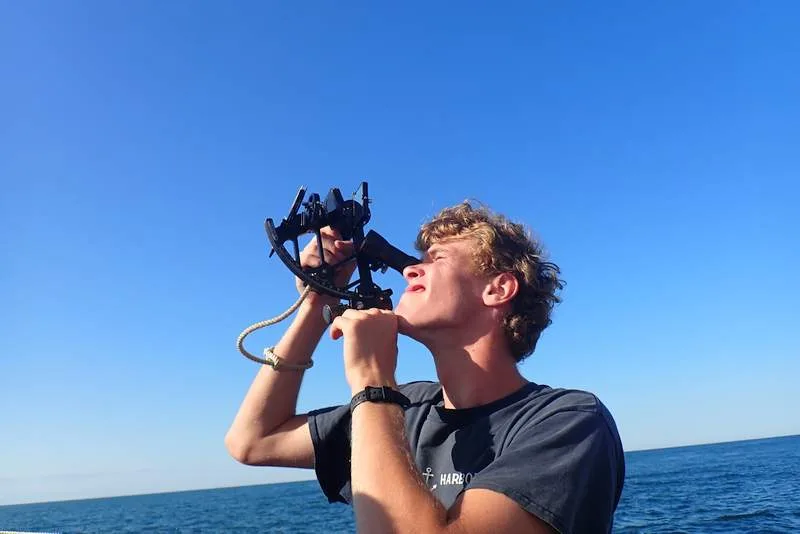Programs Blog
Sailing all day!

Author: Riya Singh, B watch, Milton Academy and Curtis Corzine, A watch, East Helena High School
Ship’s Log
Noon Position
41° 13.125’N x 71° 29.773’W
Ship Heading
200 degrees
Ship Speed
5.7 knots
Taffrail Log
510.9 nm
Weather / Wind / Sail Plan
Wind coming from South, force 4. Sea direction South at 1.5 feet in height.
Description of location
Leaving Narragansett, Rhode Island
We left our anchorage in Narragansett, Rhode Island near Judith Point. It was a perfect day to set sail! We set the main, main staysail, fore staysail, jib, and the jib topsail. Near Block Island and the wind farm, we deployed a new net today at about 1100. This net is called the meter net and it was towed 30 meters below the surface, collecting phytoplankton and zooplankton samples. Unlike the neuston net, this net samples deeper waters and has a more complicated deployment procedure.
 B Watch (Anna, Assistant Scientist; Riya; Jamie; Aidan) sets sails.
B Watch (Anna, Assistant Scientist; Riya; Jamie; Aidan) sets sails.
In order for the net to avoid hitting the boat it is crucial that the stern be turned away from the deployment side. After the deployment, which took 30 minutes in total, we headed into Narragansett Bay in order to circumnavigate Conanicut Island/ Jamestown Island because of rough weather out in open water. For class today we practiced our emergency drills such as the Man Overboard (MOB), Fire, and Abandon Ship. After class and the completion of the circumnavigation, the weather had subsided in the evening and we returned to the open water for another meter net tow and other scientific deployments.
– Riya Singh, B watch, Milton Academy and Curtis Corzine, A watch, East Helena High School
Contact: Douglas Karlson, Director of Communications, 508-444-1918 | dkarlson@sea.edu
Recent Posts from the Ships
- Ocean Classroom 2024-A collaborative high school program with Proctor Academy
- Collaborations and Long-term Commitments: SEA’s Caribbean Reef Program Sets a Course for Coastal Programs that Compliment Shipboard Experiences.
- Sea Education Association students prepare for life underway using state of the art nautical simulation from Wartsila Corporation.
- SEA Writer 2022, Magazines From the Summer SEA Quest Students
- Technology@SEA: Upgrades Allow Insight into Ocean Depths
Programs
- Gap Year
- Ocean Exploration
- High School
- Science at SEA
- SEA Expedition
- SEAScape
- Pre-College
- Proctor Ocean Classroom
- Protecting the Phoenix Islands
- SPICE
- Stanford@SEA
- Undergraduate
- Climate and Society
- Climate Change and Coastal Resilience
- Coral Reef Conservation
- Marine Biodiversity and Conservation
- MBL
- Ocean Exploration: Plastics
- Ocean Policy: Marine Protected Areas
- Oceans and Climate
- Pacific Reef Expedition
- The Global Ocean: Hawai'i
- The Global Ocean: New Zealand